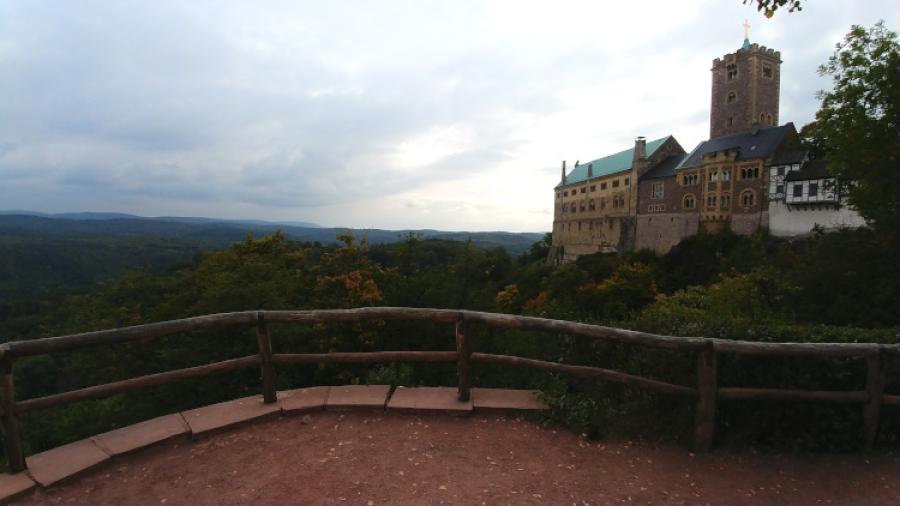The Reformation at 500: Luther’s Stay at the Wartburg (Part 1)
Image

Wartburg Castle
Read the series.
Why should we praise God—or, for that matter, even care—that Dr. Martin Luther has triumphantly “driven the devil away with ink”?1
For the benefit of those who do not follow this column regularly, let me back up and open with a brief word of explanation. Since beginning to write in this format in 2020, I have been producing an ongoing series, in which I follow the events of the Reformation throughout its 500th anniversary. The big event, of course, occurred on Oct. 31, 1517. Its anniversary took place before I began this column, but was just a month after my wife and I were privileged to be on a life-changing Reformation tour of Germany, including a stop at the Castle Church, where Luther nailed his 95 theses to the door. There will, of course, continue to be anniversaries of significant Reformation events, 500 years later, for the rest of my life.
I have been away from this topic for just about one year, and that was not by accident. This past year marked 500 years from Luther’s unplanned stay at the Wartburg Castle. He was there from May 4, 1521, to Feb. 29, 1522.2 Although we are late in commemorating his departure, the next six months were quiet for Luther, so I will attempt to catch up and summarize this entire period according to some vitally important themes.
We left off in this ongoing series by observing in amazement as friendly kidnappers hoisted Luther off of his carriage and swept him away to the frightfully magnificent Wartburg Castle—which would genuinely function as his mighty fortress.
As we approached the Wartburg on the Sunday afternoon of our Reformation trip back in 2017, I could barely comprehend the awesome nature of the things that I was seeing. It is only a few minutes through the Thuringian Forest to get from the Bach House, where we finished our tour of Eisenach, to the Wartburg. I wondered if our tour bus could make it up the mountain. In fact, it did stop to let out a few who wanted to finish the journey the old-fashioned way, in spite of the raindrops. Then the rest of us were shuttled up in vans that could manage the steep, sharp mountain curves. I’m not sure how a team of horses would fare, or how long it would take to make the entire journey on foot.
What a job it must have been for 16th-century peasants to carry food up to the castle! As I wrote in my previous column, one has to wonder how many sacrificed their lives in the process of building and maintaining the structure throughout the five centuries before Luther’s day.
We visited the castle in late September, but if you were looking for a day to celebrate Halloween—or, more appropriately, Reformation Day—this would have been it. There was a light mist falling through the gloomy, late-afternoon sky.
I realized that, back home, it was about time for Sunday School to begin. Our lesson for the day involved a firsthand experience with one of the greatest sites in church history.
Ill health plagued Luther throughout his stay at the castle, making his exceedingly frugal use of time there all the more impressive. Indeed, if Luther had done nothing else during his lifetime other than the work he completed in exile at the Wartburg, he would still be a person of monumental importance.
So, should we still care today? The answer seems evident. Yet, I must admit, it always surprises me when I find someone who is utterly unaware of the significance of the Wartburg Castle and all that transpired there. These things are, indeed, critical—not just for Luther buffs, but for all who appreciate the blessings of Western civilization in general, and Biblical literacy in particular.
Most notably, Luther translated the New Testament into German in just 11 weeks at the Wartburg—effectively beginning the modern era of Bible translation, and setting in motion a series of events that would impact the world for centuries.
Next time, we will delve deeper into that specific subject of Luther’s translation work, also considering the other writings he produced inside the Wartburg Castle.
It was truly by means of these ventures that he cast ink at the devil, who haunted his stay.
Notes
1 This translation of a phrase relating to a well-known incident that occurred during Luther’s stay at the Wartburg is found in numerous places, without an additional citation. See, for instance, “Legends about Luther: Throwing the Inkwell;” Luther Memorial Foundation of Saxony-Anhalt; 1997; https://www.luther.de/en/tintenfass.html; Internet; accessed 21 April 2022.
2 “Luther at Wartburg Castle;” Reformation 500, Concordia Seminary, St. Louis, MO; n.d.; https://reformation500.csl.edu/; Internet; accessed 21 April 2022.
Paul Scharf 2019 Bio
Paul J. Scharf (M.A., M.Div., Faith Baptist Theological Seminary) is a church ministries representative for The Friends of Israel Gospel Ministry, serving in the midwest. He also assists Whitcomb Ministries and writes for “Answers” Magazine and Regular Baptist Press. For more information on his ministry, visit foi.org/scharf or email pscharf@foi.org.
- 84 views

Discussion